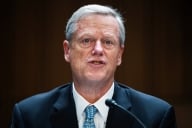You have /5 articles left.
Sign up for a free account or log in.

Wisconsin Governor Scott Walker proposed increased funding for the University of Wisconsin System.
Wisconsin governor's office
Wisconsin Governor Scott Walker’s latest two-year budget proposal has been received relatively warmly by higher education leaders, considering it calls for continuing to freeze tuition and then cutting it.
Yes, leaders have expressed reservations about parts of Walker’s plan, publicly worrying about performance metrics he wants to put in place, a proposal to allow students to opt out of some fees and a lack of funding for construction and maintenance projects. But they’ve also welcomed Walker’s proposals relating to the state’s allotment of funds for university operating budgets.
In short, that’s because the governor is executing an about-face in tone on funding for the University of Wisconsin System. After years of deep cuts, Walker is calling for putting more than $100 million in additional state spending into the system’s budget, which spans the 2017-18 and 2018-19 fiscal years. And even though he wants to lower resident undergraduate tuition by 5 percent in 2018-19, he plans to offset institutions’ lost revenue with another $35 million in state money -- on top of the extra $100 million.
The change in tone doesn’t necessarily translate to a lasting change at the bank, however. Some have questioned whether Walker’s proposal is a pre-election change of heart geared only toward winning at the polls in 2018. Wisconsin’s legislative leaders, who have significant influence over the final budget that will be enacted, have been skeptical of the governor’s higher education plans -- sometimes wondering if the money to backfill tuition cuts could be better spent on student aid. Meanwhile, some faculty and union leaders are arguing that Walker isn’t doing enough to pay for previous cuts in state allocations and an ongoing state-imposed tuition freeze that dates back to controversy over the university system’s reserves and that has been in place since the 2013-15 budget.
You don’t need elected officials or university leaders to sum up the current situation, though. Brent L. Notbohm, who chairs the University of Wisconsin Superior’s Faculty Senate, put it as follows.
“I think it’s certainly more positive than the last biennial budget,” said Notbohm, a professor of film and video. “But the devil is going to be in the details.”
The details of Walker’s $76.1 billion 2017-19 biennial budget have the state increasing spending on the University of Wisconsin System by $105.2 million over the two years combined. But it would put in place $42.5 million in performance funding based on categories like the number of graduates, time to graduation and how many graduates are employed in high-demand fields. Another $11.6 million would go to employee compensation, an important pot of money for a state higher education system whose leaders have been spending millions on nonsalary enticements like research equipment and teaching assistants in order to keep professors from leaving for higher salaries elsewhere.
The $35 million in state money to pay for the proposed 5 percent tuition cut would be on top of the $105.2 million in new spending on the University of Wisconsin System. It would save the average student $360 per year, the governor’s office estimates.
The average resident undergraduate pays just under $7,200 in annual tuition, according to Walker’s office. There is considerable range between institutions, however, with full-time annual quoted tuition for students at the university system’s two-year colleges coming in at $4,750 compared to nearly $9,300 for students of most full-time resident undergraduate programs at the flagship Madison campus. Out-of-state and international students pay significantly higher tuition rates, over $30,000 per year before factoring in fees.
Collectively, the $105 million and $35 million would help grow the University of Wisconsin System's budget from about $6.1 billion in 2017 to more than $6.2 billion in 2019. The budget would grow year to year by 1.6 percent in the first year of the biennium and 0.7 percent in the second.
Walker’s budget proposal also contains several other controversial elements. Professors and academic staff members would have their teaching loads tracked. Information on professors’ workloads would be made public, and those who teach beyond the standard load would receive rewards. The budget document does not outline exactly how the system would work, instead calling on the Board of Regents to develop a plan.
The state university system would also be required to offer three-year degree options in order to save students money. Three-year degree pathways would need to be in place for 10 percent of programs by 2018 and for 60 percent of programs by the middle of 2020. At the same time, the budget calls for requiring students to take part in internships or work experience in order to earn bachelor’s degrees.
The governor’s proposed increases come after past Wisconsin budgets have cut hundreds of millions of dollars from the university system, which has spent more than $6 billion annually in recent years. The budget for 2015-17 cut $250 million. A faculty and staff union says cuts to the system since 2011 add up to $795 million.
When he introduced his budget earlier this month, Walker focused on affordability, supporting the long tuition freeze by saying that tuition went up 118 percent in the decade before the freeze was put in place. He also argued for the 5 percent tuition cut in the budget’s second year.
“Reducing tuition by putting more money into the UW is very much like lowering property taxes by putting more money into public schools in the state,” he said, according to a transcript of his budget address delivered Feb. 8.
Walker’s budget proposals will have a difficult time making it through the Wisconsin Legislature intact, particularly the headline $35 million to pay for a tuition cut. Republican Assembly Speaker Robin Vos said after Walker’s budget was unveiled that he did not believe the governor’s tuition cut can make it through the budgeting process. Other Republicans have wondered how the state can come up with the funding needed to pay for the cut.
Leaders within the University of Wisconsin System nonetheless voiced support for the idea of more state funding.
“We are feeling very positive about the governor’s proposed budget,” system President Ray Cross said in a statement shortly after Walker released his proposal. “It is a reinvestment in the UW System as we requested, and is certainly a wonderful first step for higher education. It demonstrates the appreciation for the value and economic impact the UW System brings to Wisconsin.”
The UW System is reviewing the proposals, according to a spokeswoman. But it would like to see decisions related to tuition costs and performance-based funding made by the Board of Regents, she said.
The chancellor of the system’s flagship Madison campus, Rebecca Blank, called the additional money in the proposal a partial restoration of funding cut in the past and some new money.
“This is a welcome change from the cuts in state support in 10 out of the last 12 years (under both political parties), which created serious challenges for the entire UW System,” she wrote in a Feb. 22 blog post.
But Blank also noted that the UW system already tracks accountability measures under state law in areas of administrative management, educational performance, financial management and research and economic development. And she took aim at a limited capital budget Walker proposed that did not include funding for renovation and construction projects UW Madison requested. She did note, however that the state was providing funding for maintenance projects, something that had been missing in the last round of budgeting.
Others cautioned that the budget proposal could change significantly before it becomes law. It is critical that the state supplies funding to offset any tuition cut, said Cathy Sandeen, the chancellor of the University of Wisconsin Colleges and University of Wisconsin Extension. The University of Wisconsin Colleges are freshman and sophomore campuses where students can earn associate’s degrees and prepare to transfer into four-year programs.
While the latest budget proposal is a positive development, previous state budgets, including that for the last biennium, have taken their toll on public education, Sandeen said.
“We cut over 20 percent of administrative positions in order to meet that budget cut,” Sandeen said. “Let’s be careful to be sure that we are recouping the state money that we need to compensate for that proposed tuition decrease.”
It’s not clear what the university system would do if it ended up losing more from the 5 percent tuition cut than it gained in state reimbursement. Universities have ways to manage enrollment to make up for some funding differences. One is relying on better-paying out-of-state students. The University of Wisconsin System has already been doing that in recent years. Systemwide in-state resident undergraduate head count fell from 126,432 in 2012-13 to 117,613 in 2016-17. Systemwide nonresident undergraduate head count rose over the same period from 16,590 to 20,839.
Still, it is significant that the governor is changing his messaging regarding higher education funding, said George Pernsteiner, president of the State Higher Education Executive Officers association. Wisconsin’s recent history isn’t the only reason. Many other states are discussing cutting their funding for public higher education, Pernsteiner said.
Several of Walker’s proposals have been attempted in other states. Many others have adopted performance funding to varying degrees. Three-year degree programs have been the subject of buzz in the past as well.
The 5 percent tuition cut is effectively a buy down, another strategy that has been tried elsewhere. North Carolina is pursuing an aggressive version of a tuition buy down for some of its public campuses, for example. Even so, policy makers will have plenty to debate regarding tuition levels.
“The question that really always is asked is, when you do that, how is this addressing your affordability issues for your lowest-income students?” Pernsteiner said. “Would the money be more effectively spent in need-based aid programs?”
Faculty members also have significant concerns about the other elements of Walker’s budget. Some see the budget proposals involving faculty workload as an insult to professors who are already working extremely hard.
Ken Menningen is a professor in the department of physics and astronomy at the University of Wisconsin Stevens Point who chairs that university’s Common Council. Stevens Point professors teach four classes in both the fall and the spring, Menningen said. That 4-4 teaching load is generally considered high at colleges and universities.
“He wants us to fill out forms and say how many hours I teach this week,” Menningen said. “We did this in the past, and other states have done this, too. It’s always been an exercise in futility.”
Chad Alan Goldberg, a professor of sociology at Madison and the president of United Faculty and Academic Staff AFT Local 223, questioned funding levels and the proposed performance-based funding. Cuts to the UW system since 2011 have totaled $795 million, he said. That has meant fewer classes for students, fewer programs and larger class sizes.
Goldberg said the union supports the idea of a tuition cut but that it would be better to find a way to eliminate tuition. It is also a bad idea for Walker to set up a series of performance metrics that require institutions within the higher education system to compete for funding, “Hunger Games-style,” he said.
“There’s a concern that the metrics he’s proposed would create pretty strong incentives for the various campuses to accept fewer students who are underprepared for college,” Goldberg said. “That has implications for accessibility and higher education being an engine for social mobility.”
Student groups voiced concern about Walker’s proposal to make optional student fees known as segregated fees. Those fees fund essential services like transportation, rape crisis centers and veterans’ services, said Sally Rohrer, who chairs the legislative affairs committee of the Associated Students of Madison.
“We fear an opt-out system would create a freeloader problem, where we can’t deny students services but we cannot pay for student services,” she said. “Then nobody has those services.”
Yet to be seen is what kind of lasting influence Walker’s proposal will have on public higher education in the state. Many wonder whether the governor is making a show of investing in universities as he prepares for the 2018 election but will change his tune in the future. Some don’t believe he has changed his tone enough right now.
“It would be great if the person I worked for, the governor, would actually have a high esteem for faculty like me,” said Menningen, the Common Council Chair at the University of Wisconsin Stevens Point. “But I’m not so sure that throwing money at the UW system and saying, ‘We’re going to keep them accountable’ quite does away with that suspicion.”
Others remember previous battles that make them suspicious of state lawmakers.
Notbohm, the Faculty Senate President at the University of Wisconsin Superior, said a weakening of tenure protections in recent years still hangs heavy in the minds of professors.
“I think there is a trust issue on both sides,” Notbohm said. “The Legislature seems to lack trust for the educators, and the educators lack some trust for the Legislature.”








